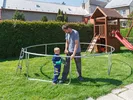By continuing to use this site, you agree to our use of cookies.
Moving Swing Sets, Swimming Pools, and Other Outdoor Equipment
Apr 19, 2022
Want to move your backyard fun to a new house?
For many families, outdoor space is an extension of their home. It’s a place to send the kids out to play, enjoy a picnic, exercise or just relax. So if you’re moving long-distance, you’ll want to bring things like trampolines and swing sets to the new home. While it’s a bit of work to take them apart, it is possible! We’ll help with each step of the process with tips and step-by-step instructions.

Figure out if it’s worth the work to move it
As you look around the backyard, there may be several oversized things to try and move. It’s important to weigh the risks and costs before committing to the project. It might be easier to leave stuff for the future residents or sell it locally. Ask yourself these questions:
- What condition is the item in? If things are rusted, splintered, worn-out, faded, or damaged, it might be worth the investment to buy new stuff after moving.
- Can you easily remove it from its anchor? If something is staked into the ground, it’s much easier to remove than concrete, which requires a sledgehammer or jackhammer.
- Do you have the necessary tools? To save time during disassembly and reassembly, use power tools instead of manual ones. Some items, like trampolines, may require specialized equipment, like a spring tool, to correctly take them apart. Check the manual or the instructions below to make sure you have what you need to get the job done.
- Do you have the space to move them? (and how much does that space cost?) Large items like swing sets, even when broken down, can take up a lot of room. Be sure to factor those items in when choosing a moving company so you’re prepared to pay for extra space. If your household goods will fill up the moving equipment (or if it’s too costly to add space), it might be best to leave things behind.
- Is there a spot at the new home for the item? Does your HOA allow it? Measure the new backyard to make sure everything will fit, and then talk with your HOA (if applicable) for any regulations. If there’s not room or permission for it at the new place, then don’t move it.
Outdoor equipment moving supplies (and how to use them)
Gather the supplies that apply to your specific items:
- Tools — depending on the type of outdoor equipment, you might need a drill/screwdriver, wrenches, Allen wrenches/hex key, hammer, or rubber mallet.
- Moving boxes — place smaller items in moving boxes to keep them from getting lost.
- Packing paper — wrap everything before it goes into a box.
- Painter’s tape and marker — label everything well.
- Zip-top bags — keep screws and bolts together.
- Paper padding — wrap poles and frames to protect them.
- Plastic stretch wrap — bundle similar pieces together for easy loading and reassembly.
- Tarps or sheets — lay down a tarp or sheet in the moving equipment before loading for another layer of protection, then place a second covering over the items to prevent rust or dirt from transferring.
- Rope, straps or bungee cords — tie everything down well, so nothing moves during transit.
Use these tips when moving outdoor equipment
Find the manual
Dig out the instruction booklet or look it up on the manufacturer’s website so you can follow the steps for taking it apart. If the manual doesn’t include disassembly instructions, reverse the instructions for putting it together.
Inspect for pests
You want to avoid small critters or insects crawling from outdoor items to your other household goods. And in some cases, a pest inspection may be required. Moves that travel to or through certain areas must comply with federal regulations to inspect and remove spongy moths and their eggs. The moving company will alert you if those regulations applies to your move.
Consider calling in a professional
Companies that install pools and swing sets can also help you move them. Call in the experts if you don’t have the time or ability to take it apart.
Take pictures
Snap close-up shots of any connections, so you’ll be able to see where things go when putting it back together.
Label everything
Use painter’s tape to clearly label all pieces (like “left front swing set leg”). As you take screws and bolts out, place them in labeled zip-top bags and then tape the bag to the related piece.
Order replacement parts
If you notice any pieces that need replacing, contact the company and have parts shipped to the new home. However, keep the broken parts with you in case they require you to send them back.
Be careful in the winter
Boards and stakes can be more prone to breakage in the cold. If possible, move the item to the garage for warmth before taking it apart.
Taking a trampoline apart to move it
If you’re moving locally, you could transfer the trampoline intact on a trailer, but it’s best to take it apart for long-distance moves. Make sure you have a spring tool (order one if not). While you could use pliers, they have the potential to scratch and bend the springs.
Take the trampoline apart in this order:
- Remove the safety net and pads.
- Remove springs by hooking the tool under the end attached to the D- or V-ring, pulling it until the spring extends to loosen, then slipping the spring off the ring.
- Fold the mat using the round edge as a guide. Once folded to 1/4 or 1/8, you can bundle the mat together.
- Disassemble the frame and legs.
How to move a swing set or play set
Most play sets have many pieces. You don’t have to break it all the way down — just make it the right size to fit in the moving truck.
- Spray bolts with corrosion solvent an hour before disassembly to help loosen stuck nuts and bolts.
- Remove parts from the main structure (swings, slides, ladders, monkey bars, etc.).
- Disconnect cross pieces.
- Break down the frame as much as necessary to fit it inside the moving equipment.
Steps for disassembling and moving an above ground pool
Ensure the pool is completely drained, clean and dry before taking it apart. Then, go in this order:
- Remove the liner and roll it as tightly as possible.
- Take off any wall components (skimmers, returns, ladder, steps, etc.).
- Remove upright support beams.
- Take off the pool wall and roll it tightly.
- Disconnect and flush the filter system.
Moving other outdoor equipment
There are endless possibilities for the things that could be in your yard: basketball goals, storage boxes, patio furniture, grills, lawn tools and more. While each one will come apart differently, follow these guidelines:
Make sure everything is clean, dry and drained of fluids
emove grease, crumbs, dirt, grass, mud or other debris. Drain lawnmowers, weed eaters, chain saws and other gas-powered tools of flammable fluids like gasoline and oil. Remove propane tanks or charcoal (take those things with you — don’t pack them in the moving equipment).
Disconnect power sources
You don’t want anything turning on while traveling. Remove batteries or disconnect spark plugs to be safe.
Cover sharp objects
Using paper padding and stretch wrap, cover sharp edges like those on chain saws, rakes and umbrella tips so these items don’t dull or cause damage to other belongings.
Take it apart as much as possible/necessary
Use your best judgment here. For example, if you have room for an entire patio table, keep it together. But things like basketball goals will need to be broken down. Follow the tips above and take pictures, label and contain the pieces. If tables have glass tops, wrap them well in paper padding and use a mirror box to protect the fragile sheet of glass.
Secure any moving parts
Tape down or zip tie things like grill covers, storage box lids, or anything that could open or move.
Have questions?
Leave a comment below if you need help when moving a trampoline, swing set or other outdoor items. And when it’s time to pack up the inside of your home, use these helpful guides to learn how to pack everything from aquariums to washers.
More articles you might like...



